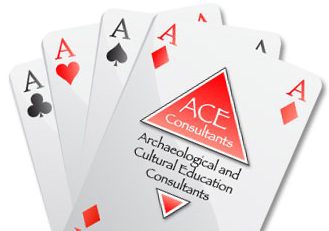The ACE Consultants offer a broad spectrum of services resulting in the development of products that meet the needs of the client, audience, and situation. Products include lesson plans, hands-on or experimental activities, workshops, and lectures.
Educational Materials
ACE Consultants creates educational materials for formal and informal learning situations. Formal learning situations are typically school-based classrooms where the group receiving the instruction is a defined unit cohesive in their age and learning level. Informal learning takes place everywhere, but the more structured informal learning opportunities include museums, camps, extra-curricular clubs, and groups such as the Boy Scouts or Girl Scouts.
Formal Educational Materials
Materials that have been created for use in formal learning environments include lesson plans, activity guides, educational units, and curricula. The following is a list of some of the programs and materials that have been specifically created for classroom use. Materials that were created in a digital format, or converted to a digital format, are available for download by clicking on the links below.
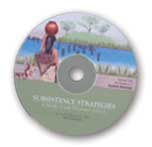
Subsistence Strategies in Middle to Late Precontact Arizona is a lesson plan for grades four through seven that includes teacher’s background information, the lesson plan, activity pages and teacher’s key, alignment to the Arizona Educational Standards, vocabulary list, and essays for students. These materials were based on information from the State Route 89A project outside of Sedona, Arizona. The educational team for this project included local teachers, cultural leaders for the Yavapai and Apache Nations, project archaeologists, and a social studies curriculum specialist with the Arizona Department of Education. The client was the Arizona Department of Transportation. [To view and download the materials, click on the links below.] For Teachers
- Lesson plan— (164k pdf)
- Vocabulary— (115k pdf)
- Resources— (106k pdf)
- Alignment to state standards— (98k pdf)
- Teacher’s keys— (557k pdf)
Readings for 4th and 5th Grade
- People of the Verde Valley— (647k pdf)
- To Farm or Not to Farm— (647k pdf)
- The Harvest Festival— (647k pdf)
Readings for 6th and 7th Grade
- Native Peoples of Arizona— (774k pdf)
- People of the Verde Valley— (647k pdf)
- To Farm or Not to Farm— (647k pdf)
- The Harvest Festival— (647k pdf)
More For Teachers
- Activity Pages— Art for Classroom Use (307k pdf)
- Illustrations— (1.5MB pdf)
- Culture Everywhere, Explore Phase Activity— (688k pdf)
- Archaic Hunter-Gatherers, Closure Activity— (639k pdf)
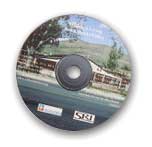
Making a Living in the Hondo Valley is a 4-lesson educational unit covering subsistence strategies and change through time in the Hondo Valley region of New Mexico. Using interview techniques, oral histories, and archaeological information, students study economics and subsistence during three distinct time periods—current day, that of their grandparents, and that of the Jornada Mogollon. In the end, students compare and contrast economics and subsistence over time. These materials were created through an archaeological contract with SWCA, Inc. (an environmental consulting firm) for the New Mexico Department of Transportation.
[To view and download the materials, click on the link below.]
- Making a Living in the Hondo Valley (to return to this page click on your browser back button)
Land-use & Lifeways a stand-alone lesson for grades five through eight, focuses on the traditional shared use area that is now considered southeastern New Mexico. The lesson plan includes instructions, essays written by archaeologists and tribal members, a vocabulary list, and an alignment to the New Mexico educational standards. Also included, is a poster on which students base their research. [To view and download the materials, click on the links below.]
- Stories of Land-Use and Lifeways, guide— (647k pdf)
- Stories of Land-Use and Lifeways, poster— (1.7 MB pdf NOTE FILE SIZE)
The Grand Adventure! El Camino Real de Tierra Adentro, The Royal Road from Mexico City to Santa Fe (¡La Gran Aventura! El Camino Real de Tierra Adentro, Un Sendero Real Entre la Cuidad de México y Santa Fé) is a four lesson educational unit based on the theme of travel and trade on the Camino Real. The materials are intended for grades five through eight, but can easily modified for use in upper division classes. The unit include teachers’ background, lesson plans, essays for students, vocabulary, and an alignment to New Mexico educational benchmarks and standards for all subjects. All materials are in English and in Spanish. English
- Welcome Travelers (44 KB PDF)
- The Grand Adventure! Lesson Plans (452 KB PDF)
- Appendices (4 PDFs – 272 KB .zip file)
- Illustrations (10 PDFs – 9.2 MB .zip file)
Español
- Bienvenidos Viajeros (52 KB PDF)
- ¡La Gran Aventura! Planes de la Lección (456 KB PDF)
- Apéndices (4 PDFs – 292 KB .zip file)
- Ilustraciones (14 PDFs – 10.5 MB .zip file)
People, Place, and Time, a comprehensive curriculum kit for grades 6–12, is focused on the archaeology and cultural history of the Tucson Basin. The kit contains a curriculum containing two units of study—The Cultural Landscape and CRM Archaeology. In the Cultural Landscape, students learn about the resources within the Tucson Basin and through experimentation, what products can be created with those resources. The unit concludes with the development of the systems necessary for creating a winter village. The CRM Archaeology Unit takes students through the process of creating an archaeological consulting business, bidding on a request for proposals, and through conducting an archaeological investigation from the generation of research questions to the completion of a technical report. The curriculum is based on data from the Bureau of Reclamation Central Arizona Project. The kit contains the curriculum, the landscape map, archaeological site board game, replica artifacts, a video on the archaeological project, and resources for teacher and student use. This kit was created for the Bureau of Reclamation. (For more information or to inquire about receiving a kit, contact ACE Consultants.)
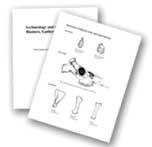
Archaeology and the Environment: Hunters, Gatherers, & Seasonality is a four lesson unit. The activities in these lessons make a link between human use of the environment and how archaeologists use archaeological evidence and environmental indicators to reconstruct the past. In the lessons, students compare present-day food-procurement strategies with those of past hunter-gatherer societies, examine food availability based on seasonality and environment, and analyze archaeological data to determine subsistence practices at an Archaic time period campsite. This unit was originally created to supplement lessons in New Mexico Project Archaeology, but can be used as a stand-alone unit. It was created under contract to the New Mexico Office of Cultural Affairs, Historic Preservation Division for the New Mexico Office of the Bureau of Land Management. [To view and download the materials, click on the link below.]
Informal Educational Materials

Materials that have been created for informal learning environments including Archaeology Day events, museums, and camps using temporary displays, static or traveling exhibits, and hands-on activities include:
The Comanche and the Tasiwóo (American Buffalo) Educational Kit. Created for the Comanche National Museum and Cultural Center, this educational kit includes a teacher’s activity guide, references and resources, photos, maps, and hands-on materials for completing the four activities included in the Guide. Activities are adapted for kindergarten through eighth grade. The kit is available for classroom use through the Comanche National Museum and Cultural Center.
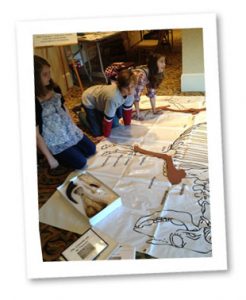
ArchaeologyLand! is a set of hands-on activities that can be used by archaeologists and educators to teach about archaeology, culture, and preservation. Activities are intended for informal learning situations. [To view and download the materials, click on a link below.]
- Organizing the Event— (201k pdf)
- Pottery Design Replication— (254k pdf)
- Pottery Design Transfer— (254k pdf)
- Split Twig Figurines— (254k pdf)
- The Archaeology Laboratory— (258k pdf)
- The Cordage Site— (516k pdf)
- The Petroglyph Site— (365k pdf)
- The Pictograph Wall— (836k pdf)
- The Pottery Village Site— (360k pdf)
- Page for visitors— (33k pdf)
- Sample event map 1— (401k pdf)
- Sample event map 2— (94k pdf)
Fulfilling our Mission—Preserving our Past, is a traveling poster exhibit on cultural resource stewardship and Arizona’s military installations designed for viewing at Arizona military installations.
Hands-on History, a 2003 Albuquerque Archaeology Day event for families, was held at the New Mexico Museum of Natural History, sponsored by the City of Albuquerque.
Workshops and Training
ACE Consultants provides workshops, lectures, demonstrations, and interactive presentations on a variety of topics relating to anthropology, archaeology, and cultural history. Content and presentation style are tailored to satisfy client requests, audience needs, location, and situation. For a flat fee, workshops are delivered at the location of the client’s choosing.
Available Workshops
Communication, Sensitive Issues, and Public Outreach was created for archaeologists, city employees, and managers involved with the recovery and interment of burials from a rediscovered historical period cemetery in downtown Tucson. This one-day workshop can be modified for other needs.

Integrating the Past: Public Programming and CRM Contracts provides training on the development of public outreach materials associated with current archaeological research. The one-day workshop covers how to develop relevant projects based on client need, situation, and budget and provides training on the development of classroom materials and presentations.
Principles of Tribal Consultation provides basic information on the government agency to tribe consultation process as related to local and federal historic preservation requirements. Topics are presented in lecture and interactive formats. Each workshop is tailored to include relevant state tribal consultation requirements and recommendations. This workshop is available in a one- or two-day format.
Classroom Presentations
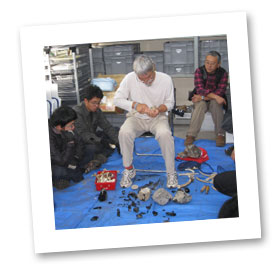
Flint Knapping demonstrations include introduction to percussion and pressure flaking techniques used in the creation of chipped stone tools such as knives, scrapers, and arrowheads. This presentation is primarily a demonstration, but a hands-on interactive format is possible.
Native North America is the story of the peopling of the North American continent from the first peoples up to the present. The information incorporates traditional as well as scientific understandings of the most current scientific information available about this fantastic journey into the New World. Lecture length and depth can be modified to meet client need.
Native Science is a lecture-based presentation on the Native scientific thinking needed to create pottery, grow plants, and use and manipulate the local environment. This presentation is also available as a hands-on activity-based workshop.
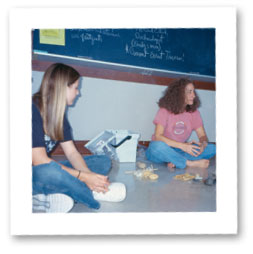
Site Formation and the Archaeological Process is a 45-minute interactive presentation that introduces information on ways that pre-contact cultures selected a place to live, established patterns that can be seen on the ground surface, and how years after abandonment, the archaeological process can provide an understanding of the remaining materials.
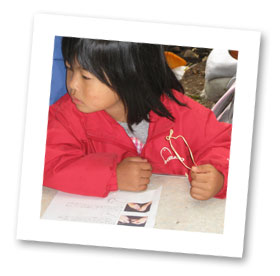
Tying the Past Together: Relating Past and Present Cultures through Cordage is a hands-on activity that teaches cordage making and introduces information on how past cultures used cordage. Interwoven within the presentation are traditional stories about objects made with cordage. (This presentation follows the Parallel Perspectives process.)
Who Owns the Past? is a lecture-based presentation that examines some of the ethical and social issues involved in researching, interpreting, and presenting information about the past. Contemporary controversies over heritage issues, representation of cultural groups within museums and the media, and the political uses to which the past may and has been put are just a part of the points that this presentation brings out. All audiences benefit from the examination of the ways that the “past” continues to impact cultures in the present.
Additional workshops and training can be developed to fit specific needs.
Archaeological and Cultural Education Consultants, LLC
PO Box 31121, Tucson, AZ 85751 (520) 272-8721
